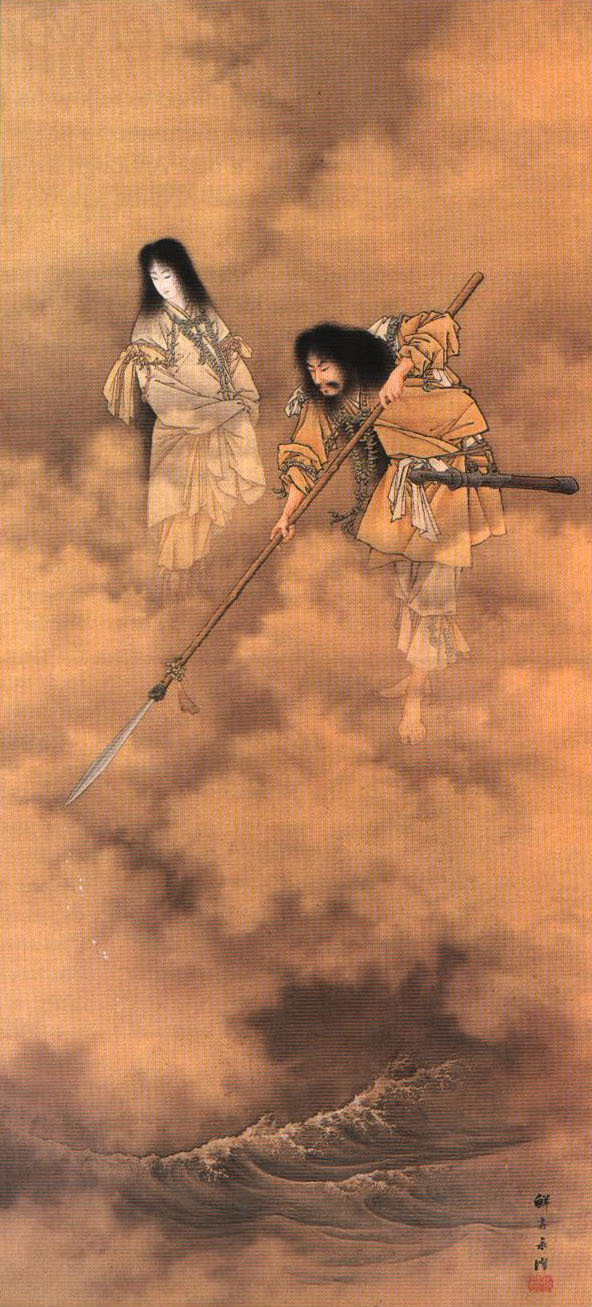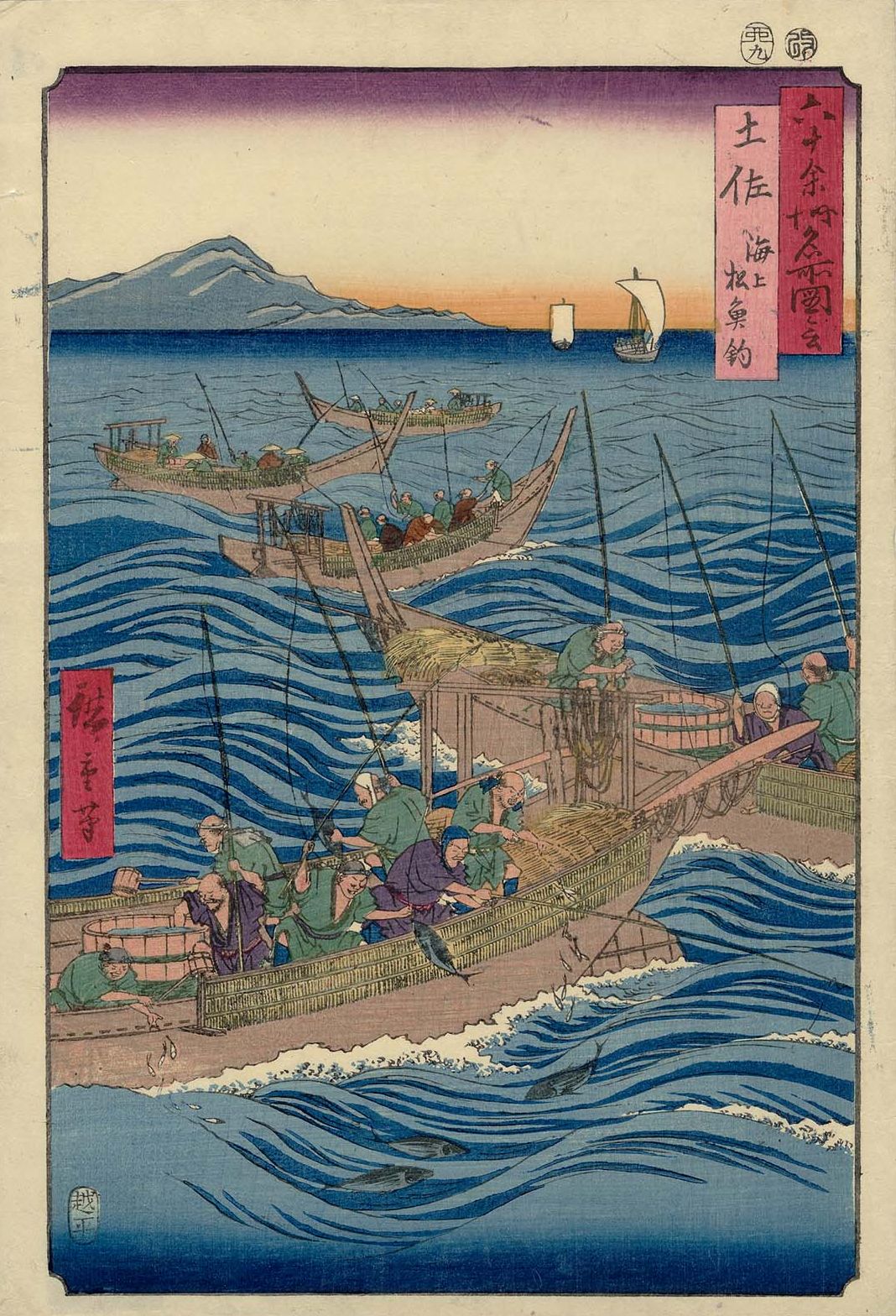|
Kuniumi
In Japanese mythology, is the traditional and legendary history of the emergence of the Japanese archipelago, of islands, as narrated in the Kojiki and Nihon Shoki. According to this legend, after the creation of Heaven and Earth, the kami, gods Izanagi and Izanami were given the task of forming a series of islands that would become what is now Japan. In Japanese mythology, these islands make up the known world. The creation of Japan is followed by the creation of the gods (''kamiumi''). Creation story According to the Kojiki After the formation, Heaven was above and Earth was still a drifting soft mush. The first five gods named were lone deities without sex and did not reproduce. Then came the , consisting of two lone deities followed by five couples. The elder gods delegated the youngest couple Izanagi and Izanami to carry out their venerable mandate: to reach down from heaven and give solid form to the earth. This they did with the use of a precious stone-covered spear nam ... [...More Info...] [...Related Items...] OR: [Wikipedia] [Google] [Baidu] |
Amenonuhoko
, also known simply as the , is the name given to the spear in Shinto used to raise the primordial land-mass, '' Onogoro-shima'', from the sea. It is often represented as a naginata. According to the ''Kojiki The , also sometimes read as or , is an early Japanese chronicle of myths, legends, hymns, genealogies, oral traditions, and semi-historical accounts down to 641 concerning the origin of the Japanese archipelago, the , and the Japanese imperia ...'', Shinto's genesis gods Izanagi and Izanami were responsible for kuniumi, creating the first land. To achieve this, they received a spear decorated with magatama, jewels from the older heavenly gods. The two deities then went to the bridge between heaven and earth, ''Ame-no-ukihashi'', and churned the sea below with the naginata. When drops of salty water fell from the tip, they formed into the first island, '' Onogoro-shima''. Izanagi and Izanami then descended from the bridge of heaven and made their home on the island. Ya ... [...More Info...] [...Related Items...] OR: [Wikipedia] [Google] [Baidu] |
Onogoroshima
Onogoroshima (: ''Onogoro-shima''; : ''Onogoro-jima'') is an important island in Shinto. The name derives from (''ono'', "self") + (''koru'', "to coalesce, to aggregate together") + (''shima'', "island").''Nihon Kokugo Daijiten'', entry available onlinhere(in Japanese) Shinto account According to the Kojiki, Onogoroshima was created ('' kuniumi'') when the divine couple Izanagi and Izanami churned the sea with the Amenonuhoko (heavenly spear) from their vantage point on the floating bridge of heaven.Kurano, , page 53 When they raised the spear from the ocean, drops fell from the spear, forming the island. They built a palace on top with a great column in the middle. The siblings walked around this pillar in opposite directions, and when they encountered each other, they were married. This island is where Hiruko (Ebisu) was born. The island is mentioned only three times in the Kojiki, at ch.3:3, ch:7:25, and ch.111:32.Philippi's translation, p. 49, p. 57, and p. 306. ... [...More Info...] [...Related Items...] OR: [Wikipedia] [Google] [Baidu] |
Japanese Mythology
Japanese mythology is a collection of traditional stories, folktales, and beliefs that emerged in the islands of the Japanese archipelago. Shinto traditions are the cornerstones of Japanese mythology. The history of thousands of years of contact with Chinese and various Indian myths (such as Buddhist and Hindu mythology) are also key influences in Japanese religious belief. Japanese myths are tied to the topography of the archipelago as well as agriculturally-based folk religion, and the Shinto pantheon holds uncountable ''kami'' (" god(s)" or "spirits"). Two important sources for Japanese myths, as they are recognized today, are the and the . The , or "Record of Ancient Matters," is the oldest surviving account of Japan's myths, legends, and history. Additionally, the ''Shintōshū'' describes the origins of Japanese deities from a Buddhist perspective. One notable feature of Japanese mythology is its explanation of the origin of the Imperial Family, which has been used h ... [...More Info...] [...Related Items...] OR: [Wikipedia] [Google] [Baidu] |
Oki Islands
The is an archipelago in the Sea of Japan, the islands of which are administratively part of Oki District, Shimane Prefecture, Japan. The islands have a total area of . Only four of the around 180 islands are permanently inhabited. Much of the archipelago is within the borders of Daisen-Oki National Park. Due to their geological heritage, the Oki Islands were designated a UNESCO Global Geopark in September 2013. Geology The Oki Islands are volcanic in origin, and are the exposed eroded summits of two massive stratovolcanoes dating approximately 5 million years ago to the Tertiary and Quaternary periods. Dōgo to the east is the largest island in area, and has the highest elevation, Mount Daimanji, at above sea level. The Dōzen group of islands to the west are all portions of single ancient volcanic caldera which collapsed, leaving three large islands ( Nishinoshima, Nakanoshima and Chiburijima) and numerous smaller islands and rocks in a ring formation surrounding a ... [...More Info...] [...Related Items...] OR: [Wikipedia] [Google] [Baidu] |
Tosa Province
was a province of Japan in the area of southern Shikoku. Nussbaum, Louis-Frédéric. (2005). "''Tosa''" in . Tosa bordered on Awa to the northeast, and Iyo to the northwest. Its abbreviated form name was . In terms of the Gokishichidō system, Tosa was one of the provinces of the Nankaidō circuit. Under the '' Engishiki'' classification system, Tosa was ranked as one of the "middle countries" (中国) in terms of importance, and one of the "far countries" (遠国) in terms of distance from the capital. The provincial capital was located in what is now the city of Nankoku. The '' ichinomiya'' of the province is the Tosa shrine located in the city of Kōchi. retrieved 2011-08-09 [...More Info...] [...Related Items...] OR: [Wikipedia] [Google] [Baidu] |
Awa Province (Tokushima)
was a province of Japan in the area that is today Tokushima Prefecture on the island of Shikoku. Nussbaum, Louis-Frédéric. (2005). "''Awa no Kuni''" in . Awa was bordered by Tosa, Sanuki, and Iyo Provinces. Its abbreviated form name was . In terms of the Gokishichidō system, Awa was one of the provinces of the Nankaidō circuit. Under the '' Engishiki'' classification system, Awa was ranked as one of the 35 "superior countries" (上国) in terms of importance, and one of the "middle countries" (中国) in terms of distance from the capital. The provincial capital was located in what is now the city of Tokushima. History Awa has been settled since the Japanese Paleolithic and the remains of Yayoi and Kofun period settlements and burial mounds have been found especially in the fertile Yoshino River valley. Per the '' Kogo Shūi,'' the name of the province was originally written "粟国" and was associated with the production of millet. Per the '' Kujiki'', the ''kuni n ... [...More Info...] [...Related Items...] OR: [Wikipedia] [Google] [Baidu] |
Sanuki Province
was a province of Japan in the area of northeastern Shikoku. Nussbaum, Louis-Frédéric. (2005). "''Sanuki''" in . Sanuki bordered on Awa to the south, and Iyo to the west. Its abbreviated form name was . In terms of the Gokishichidō system, Sanuki was one of the provinces of the Nankaidō circuit. Under the '' Engishiki'' classification system, Sanuki was ranked as one of the "upper countries" (上国) in terms of importance, and one of the "middle countries" (中国) in terms of distance from the capital. The provincial capital was located in what is now the city of Sakaide, but its exact location was only identified in 2012. The '' ichinomiya'' of the province is the Tamura jinja located on the city of Takamatsu. retrieved 2011-08-09 ...
|
Iyo Province
was a Provinces of Japan, province of Japan in the area of northwestern Shikoku.Louis-Frédéric, Nussbaum, Louis-Frédéric. (2005). "''Tosa''" in . Iyo bordered on Sanuki Province to the northeast, Awa Province (Tokushima), Awa to the east, and Tosa Province, Tosa to the south. Its abbreviated form name was . In terms of the Gokishichidō system, Iyo was one of the provinces of the Nankaidō circuit. Under the ''Engishiki'' classification system, Iyo was ranked as one of the "upper countries" (上国) in terms of importance, and one of the "far countries" (遠国) in terms of distance from the capital. The kokufu, provincial capital was located in what is now the city of Imabari, Ehime, Imabari, but its exact location is still unknown. The ''ichinomiya'' of the province is the Ōyamazumi Shrine located on the island of Ōmishima in what is now part of Imabari. [...More Info...] [...Related Items...] OR: [Wikipedia] [Google] [Baidu] |
Shikoku
is the smallest of the List of islands of Japan#Main islands, four main islands of Japan. It is long and between at its widest. It has a population of 3.8 million, the least populated of Japan's four main islands. It is south of Honshu and northeast of Kyushu. Shikoku's ancient names include , , and , and its current name refers to the four former provinces of Japan, provinces that make up the island: Awa Province (Tokushima), Awa, Tosa Province, Tosa, Sanuki Province, Sanuki, and Iyo Province, Iyo. Geography Shikoku Island, comprising Shikoku and its surrounding islands, covers about and consists of four Prefectures of Japan, prefectures: Ehime Prefecture, Ehime, Kagawa Prefecture, Kagawa, Kōchi Prefecture, Kōchi, and Tokushima Prefecture, Tokushima. Across the Seto Inland Sea lie Wakayama Prefecture, Wakayama, Osaka Prefecture, Osaka, Hyōgo Prefecture, Hyōgo, Okayama Prefecture, Okayama, Hiroshima Prefecture, Hiroshima, and Yamaguchi Prefectures on Honshu. To th ... [...More Info...] [...Related Items...] OR: [Wikipedia] [Google] [Baidu] |






